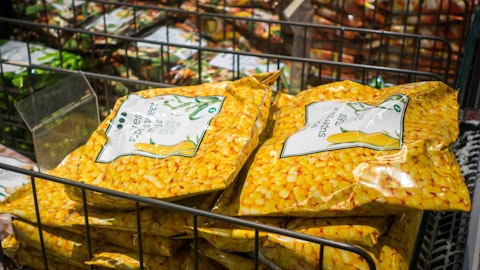We’re really pleased with the retention of our sales force. The productivity topic, Lauren, is more about our supply chain. And let me just talk about that for a minute. I’ve not spoken about that yet this morning. We grew our gross profit dollars more than we grew our expenses in Q1. And we’re pleased by that. We posted positive net operating leverage. We’re really pleased with the work that Kenny has led on CapEx [ph]. We’ve led through reduction in CapEx year-over-year and Kenny can talk more about that in a moment. On the cost per piece side, we continue to make progress. Year-over-year, Q1 versus Q1 in our main U.S. business, retention is up, pieces per labor hour is up, pieces for transportation truck miles are up. And we’re pleased with the progress that we’re making.
I also want to be clear. There’s still more progress to be made. We’re not yet back to 2019 productivity levels. And we will continue to be very focused on that. And there’s upside into forward facing periods and years as we continue to improve our productivity. And that is in our guide. We expect to make increased progress and continued progress. And those performance improvements are in our year-to-go guidance. Kenny, I’ll toss to you for any additional comments?
Kenny Cheung: Thanks, Kevin. So a few points for me. First is in addition to the supply chain productivity Kevin’s just mentioned, the corporate initiatives we outlined last call, the $100 million, that is underway and that is going to be realized ratably across the four quarters because we started on day one. That’s number one. And if you look at the P&L from a corporate SG&A standpoint, we were down 7% year-on-year. That’s point number one. Number two, in terms of the way to think about the pacing of the adds, I’ll say one thing. We will be disciplined and deliberate on when and how and where we add, meaning we still expect to achieve positive operating leverage even with the heads that we’re adding. So GP growing faster than expenses and bottom line growing faster than top point.
Lauren Silberman: Thank you.
Kevin Hourican: Thanks, Lauren.
Operator: Thank you. We’ll take our next question from Joshua Long with Stephens Inc. Your line is now open.
Joshua Long: Great. Thank you for taking my question. Kevin, you talked about the supply chain overall becoming healthier. That’s a continuation of trends we’ve seen and a lot of the great work that you and your teams are doing. I wanted to see if you might be able to dig in a little bit more there in terms of, obviously, expanding capacity and the labor scheduling tools that you offered there are exciting and measuring the pace of dividends going forward. Can you talk about the underlying labor environment? We didn’t spend much time talking about it in the prepared remarks. And I imagine that’s because it’s largely stabilized or largely improving as you start to think about just all the culminating work that you’ve done over the last several quarters.
But curious if you could provide kind of any additional thoughts there in terms of the overall labor environment, maybe at the warehouse and kind of all the other scaling up that you’ve done over the last couple of quarters?
Kevin Hourican: Josh, thank you for the question. We feel good about our staffing levels across the enterprise globally and domestically. We’re fully staffed as a network. That doesn’t mean in every single site, in every single job that we’re fully staffed. But in the network wide, we are feeling good about our staffing. We are fully staffed. And the labor market I’d say is mostly returned to kind of pre-COVID levels of inbound applicant flow for our jobs, and that’s a good thing. Retention is improving year-over-year, and that’s a good thing. Turnover is still elevated versus pre-COVID levels and that’s something we’re very focused on. But year-over-year, retention is improved and that’s what’s driving our improvements in pieces per labor, our productivity and it’s what’s driving improvements in our transportation metrics as well.
That progress will continue, as I mentioned. Q2 through Q4 this year, we’ve got our team very focused. There are four key drivers of our ops expense; pieces per truck, our overall productivity, pieces per labor hour shrink, and safety. Those are the big four key metrics from an operations perspective. And if you interviewed any leader at Sysco, they would be able to tell you there was four, and we have everyone meaningfully focused on making progress against each of them. And that’s the good news is that there’s progress to be made in each of those critical four. We’re making sequential improvement week-over-week, month-over-month, quarter-over-quarter, and there’s still progress to be made. The staffing tool that I mentioned will pay dividends for the long term.
It’s muscle being built. This business is more flattish versus retail, which is very choppy with monthly promotions and certainly the Christmas holiday season. We don’t have that degree of seasonality. But we do actually have meaningful seasonality. We have schools that are on and off. We have northern hemisphere that is much busier in the summer than it is in the winter. And then that flips where places like Florida get really busy in the wintertime. We are going to be more effective in our feature at managing our staffing levels to match those fluctuations in volume, leveraging technology, leveraging discipline, staffing tools, and that’ll help reduce our cost to serve over time. Josh, back to you if you have a follow up.
Joshua Long: Great, thank you. I did. It was also encouraged by the improving profit profile you’ve talked about versus historical periods. So I imagine all of the initiatives and work that you just outlined there go into being able to service those new accounts that you bring on more profitably. But curious if you could talk a little bit more about that at a high level in terms of just other maybe systems, tools, procedures, behind the scenes that are helping to drive that improving profit profile as you go forward?
Kevin Hourican: Yes, I’ll start on that question. Then I’ll toss to Kenny if he has anything to add to that question. Yes, we’re very pleased with the progress that we’re making on GP dollars per case. I’ll just go back to Lauren’s question about the opportunity we have to win net new. We’re better now at prospecting those customers to go after. It’s not just go out and win a customer. You can win a small customer and add a lot of expense to your network by bringing on a small account, and then having them never matriculate up to a minimum profit threshold. It’s a waste of time actually to send our sales reps out to those types of accounts. So our CRM is quite robust. And we have a lot of market intelligence. The opportunity by door [ph] on what that account can do, and we’re getting better and better at being able to target our sales reps to those high propensity accounts and really focusing on winning them.
That’s comment one. Comment two, the other things that are driving GP dollars per case are actually in the buying side of our business. Our strategic sourcing efforts are continuing to make progress as we bring down our COGS and do so in a way that is stronger than the rest of the industry. It’s a strength of ours. Topic three is Sysco brand penetration, especially at the local level. We continue to advance penetration of Sysco brand, and that’s a huge strength point for Sysco. And then if you add the pieces that I talked about from a supply chain perspective on increasing the pieces per truck for the routes that we send out, increasing the productivity of our team, net-net all together, that’s what drives a gross profit growth greater than expense growth, which allowed double digit bottom line growth at Sysco.
Kenny, over to you for any additional comments.
Kenny Cheung: Yes, just one point to add. If you’d look at the gross profit line in the quarter, I know usually we talk about gross profit versus expenses, but I think it’s worth pointing out that gross profit grew faster than sales, which is a proof point that what Kevin just mentioned, we are managing deflation in the quarter with discipline on the pricing tools side. Sysco brand, as Kevin mentioned, grew 53 bps on the local side for our business, strategic sourcing initiatives and the continued growth of our specialty business as well. On the corporate side, as I mentioned, $100 million is locked in for the year, and we’re not stopping. We are looking for more as we speak. I know in the prepared remarks, we talked about Canada. As I’m looking at my own function, we’re looking at finding better ways to drive outcomes more with less. So overall, I would say we are on pace with our productivity targets for the year and again looking for more.




